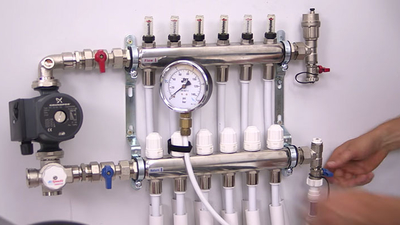Underfloor heating best practices

It may come as no surprise, but the demand for underfloor heating (UFH) is increasing. According to the ‘Underfloor Heating Market by Component – Global Forecast 2023’ the UFH market is set to reach $4.23 billion by 2023, rising from $2.53 billion in 2016.
So, as plumbing and heating installers, how can you reap the full rewards of this growing trend? The answer is in being fully aware of how to properly install UFH and knowing this heating technology like the back of your hand. If you don’t, you are at the risk of losing business opportunities, project delays, site revisits, ineffective systems, unhappy customers and ultimately, lost money.
Here are five best practices installers should follow to successfully complete their UFH projects.
Plan out the project and materials
As most seasoned plumbing and heating installers know, the planning stage is the most important part of any project, but even more so with UFH. By mapping out and planning the UFH installation properly, you will understand exact customer requirements and what materials are needed for the job.
It is imperative to measure and map out the pipework correctly. By doing so, you will know the type of fittings, fixtures and amount of pipework that will be required, and materials can be ordered in time.
If you are in a tight spot, feel free to get in touch with our dedicated design and technical support team that can help by providing project estimates, CAD designs and technical support to get you started with your project.

Think about zoning and thermostats
It also helps to think ahead about the more complex areas of the project, such as booking an electrician to assist with the installation of the wiring centre and thermostats.
The beauty of UFH systems is that you can create zones within a property and individual thermostats can be used to heat up only the zones that are in use. However, to achieve this, the UFH wiring centre must be installed correctly, and in collaboration with electricians.
Take a look at our smart JG Underfloor Heating Controls and wiring centre that come with simple wiring diagrams and instructions to help installers on-site.
Understand the floor type
Before embarking on any UFH project, you must understand the floor type you’re working with. This is because floor construction plays a huge part in UFH, and will determine what system is required.
Screed floors require staple or clip rail systems, whereas suspended wood joisted floors need an underfit system or spreader plates. If the UFH installation spans across multiple floors, the best way to approach this is by separately planning for different floor constructions within the same building.
For retrofit projects, it’s also important to remember that different floors will transmit heat differently and will need different systems. If you’re unsure of what system to use, you can head to our handy underfloor heating system selector to find out more.

Remember to install the conduit pipe
Never forget the conduit pipe as it acts as a protective sleeve for pipes coming up to the manifold and shields them from getting damaged. The conduit also prevents excessive heat from building up in areas where the manifold is installed, as several pipes carrying hot water are connected close together. Excessive heat build-up can cause cracks in the screed and damage the floor.

Always perform a pressure test
Following installation, plumbers should always undertake a pressure test using water, before the floor has been laid. For example, if the UFH pipework is going to be covered with screed, a pressure test at 2 bar for 10 minutes should be performed, followed by a test at 10 bar for a further 10 minutes.
Leave the pipework at 6 bar before laying the flooring and maintain this pressure until the screed has been cured, as this will stop the floor from cracking in the future.
Get a free CAD design and estimate
If you are looking for advice on your next UFH project, get in touch with our technical support team.
